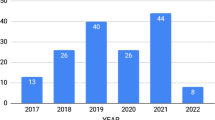Abstract
In this paper, we present a model of a trust-based recommendation system on a social network. The idea of the model is that agents use their social network to reach information and their trust relationships to filter it. We investigate how the dynamics of trust among agents affect the performance of the system by comparing it to a frequency-based recommendation system. Furthermore, we identify the impact of network density, preference heterogeneity among agents, and knowledge sparseness to be crucial factors for the performance of the system. The system self-organises in a state with performance near to the optimum; the performance on the global level is an emergent property of the system, achieved without explicit coordination from the local interactions of agents.
Similar content being viewed by others
References
Abdul-Rahman, A., & Hailes, S. (2000). Supporting trust in virtual communities. In Proceedings of the 33th Annual Hawaii International Conference on System Sciences, IEEE Press.
Amaral L.A.N., Scala A., Barthélémy M., Stanley H.E. (2001). Classes of small-world networks. Proceedings of the National Academy of Sciences 97(21): 11149–11152
Barabasi A.-L., Albert R. (1999). Emergence of scaling in random networks. Science 286, 509–512
Battiston S., Bonabeau E., Weisbuch G. (2003). Decision making dynamics in corporate boards. Physica A 322, 567
Battiston S., Catanzaro M. (2004). Statistical properties of board and director networks. European Journal of Physics B 38, 345–352
Battiston, S., Walter, F. E., & Schweitzer, F. (2006). Impact of trust on the performance of a recommendation system in a social network. In Proceedings of the Workshop on Trust in Agent Societies at the Fifth International Joint Conference on Autonomous Agents and Multi-Agent Systems (AAMAS’06).
Battiston S., Weisbuch G., Bonabeau E. (2003). Spread of decisions in the corporate board network. Advances in Complex Systems 6(4): 631–644
Bollobás, B. (1985). Random graphs. Academic Press.
Brin S., Page L. (1998). The anatomy of a large-scale hypertextual Web search engine. Computer Networks and ISDN Systems 30(1–7): 107–117
Castelfranchi, C., & Falcone, R. (2001). Social trust: a cognitive approach. Trust and deception in virtual societies. Kluwer Academic Publishers, pp. 55–90.
Christianson, B., & Harbison, W. S. (1997). Why isn’t trust transitive? In Proceedings of the International Workshop on Security Protocols, pp. 171–176, Springer Verlag.
Erdős, P., Rényi A. (1959). On random graphs. Publicationes Mathematicae Debrecen 6, 290–291
Garlaschelli D., Battiston S., Castri M., Servedio V.D.P., Caldarelli G. (2003). The scale-free topology of market investments. Physica A 350(2-4): 491–499
Golbeck, J. (2006). Combining provenance with trust in social networks for semantic web content filtering. In Revised Selected Papers of the International Provenance and Annotation Workshop (IPAW 2006), Moreau, L., & Foster, I. T. (Eds.), Lecture notes in computer science. (Vol. 4145, pp. 101–108). Springer.
Golbeck, J. (2006). Generating predictive movie recommendations from trust in social networks. In Proceedings of the 4th International Conference on Trust Management (iTrust 2006), Stølen, K., Winsborough,s W. H., Martinelli, F., & Massacci, F. (Eds.), Lecture notes in computer science, (Vol. 3986, pp. 93–104). Springer.
Golbeck, J. (2006). Trust and nuanced profile similarity in online social networks. forthcoming.
Grandison T., Sloman M. (2000). A survey of trust in internet applications. IEEE Communications Surveys and Tutorials 3(4): 2–16
Gray, E., Seigneur, J.-M., Chen, Y., & Jensen, C. D. (2003). Trust propagation in small worlds. In Proceedings of the 1st International Conference on Trust Management, Nixon, P. & Terzis, S. (Eds.), Lecture Notes in computer science, (Vol. 2692, pp. 239–254). Springer.
Guha, R., Kumar, R., Raghavan, P., & Tomkins, A. (2004). Propagation of trust and distrust. In WWW ’04: Proceedings of the 13th International Conference on the World Wide Web, pp. 403–412. ACM Press,
Huang, J., & Fox, M. S. (2006). An ontology of trust: formal semantics and transitivity. In Proceedings of the 8th International Conference on Electronic Commerce (ICEC ’06), pp. 259–270. ACM Press.
Huberman B.A., Adamic L.A. (1999). Growth dynamics of the World-Wide Web. Nature 401,131
Jøsang, A., & Pope, S. (2005). Semantic constraints for trust transitivity. In Proceedings of the 2nd Asia-Pacific Conference on Conceptual Modelling (APCCM2005), Hartmann, S., & Stumptner, M. (Eds.), APCCM (Vol. 43, pp. 59–68). Australian Computer Society.
Marsh, S. (1994). Formalising trust as a computational concept. PhD thesis, University of Stirling.
Massa, P., & Bhattacharjee, B. (2004). Using trust in recommender systems: An experimental analysis. In Proceedings of the 2nd International Conference on Trust Management (iTrust 2004), Jensen, C. D., Poslad, S., & Dimitrakos, T. (Eds.), Lecture notes in computer science. (Vol. 2995, pp. 221–235). Springer,
Montaner, M., López, B., & de la Rosa, J. L. (2002). Opinion-based filtering through trust. In Proceedings of the 6th International Workshop on Cooperative Information Agents (CIA 2002), pp. 164–178 Springer.
Montaner M., López B., de la Rosa J.L. (2003). A taxonomy of recommender agents on the internet. Artificial Intelligence Review 19(4): 285–330
Mui, L., Mohtashemi, M., & Halberstadt, A. (2002). A computational model of trust and reputation for E-businesses. In Proceedings of the 35th Annual Hawaii International Conference on System Sciences, IEEE Press.
Newman M.E.J. (2003). The structure and function of complex networks. SIAM Review 45(2): 167–256
Sabater J., Sierra C. (2005). Review on computational trust and reputation models. Artificial Intelligence Review 24(1): 33–60
Sarwar, B., Karypis, G., Konstan, J., & Riedl, J. (2000). Analysis of recommendation algorithms for E-commerce. In Proceedings of the 2nd ACM Conference on Electronic Commerce (EC-2000), pp. 158–167. ACM Press.
Watts D.J., Strogatz S.H. (1998). Collective dynamics of ‘small-world’ networks. Nature 393, 440–442
Weisbuch G., Kirman A., Herreiner D. (2000). Market organisation and trading relationships. The Economic Journal 110, 411–436
Wellman B. (2001). Computer networks as social networks. Science 293, 2031–2034
Ziegler, C.-N., & Golbeck, J. (2006). Investigating correlations of trust and interest similarity. Support Systems 43(2), (forthcoming).
Author information
Authors and Affiliations
Corresponding author
Rights and permissions
About this article
Cite this article
Walter, F.E., Battiston, S. & Schweitzer, F. A model of a trust-based recommendation system on a social network. Auton Agent Multi-Agent Syst 16, 57–74 (2008). https://doi.org/10.1007/s10458-007-9021-x
Published:
Issue Date:
DOI: https://doi.org/10.1007/s10458-007-9021-x




